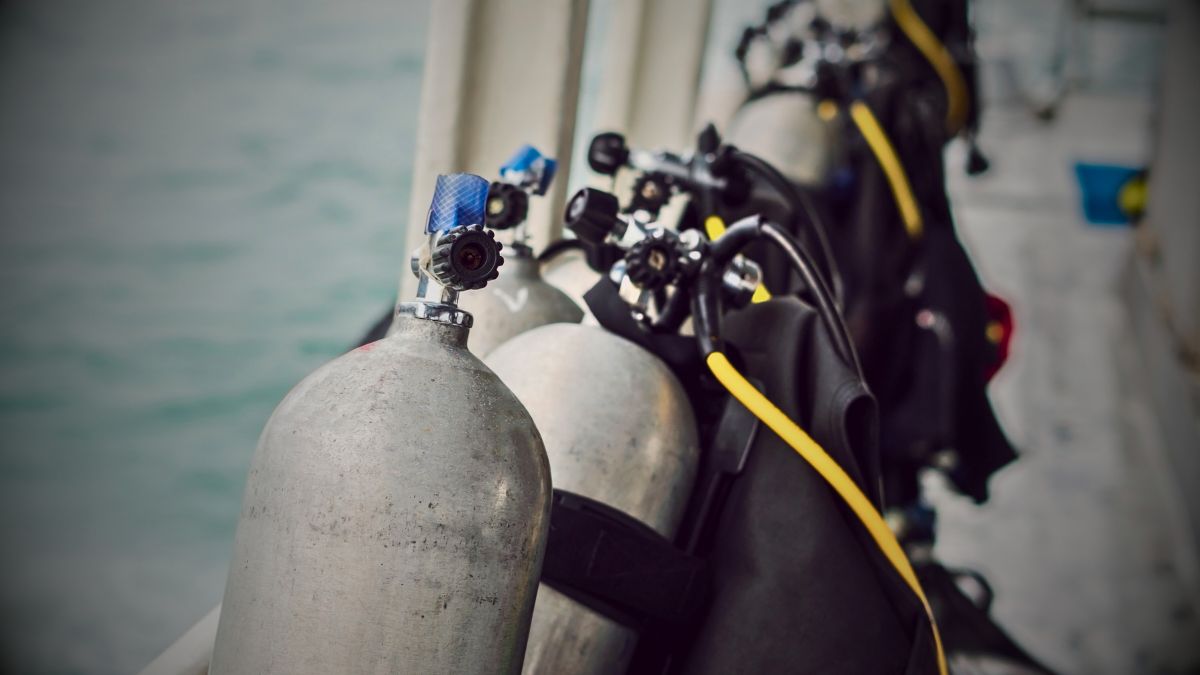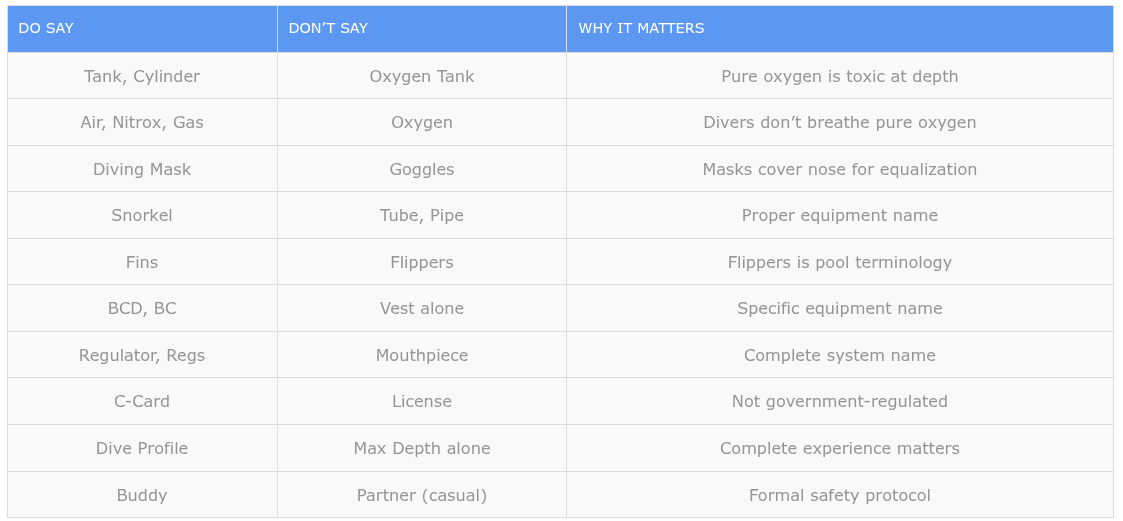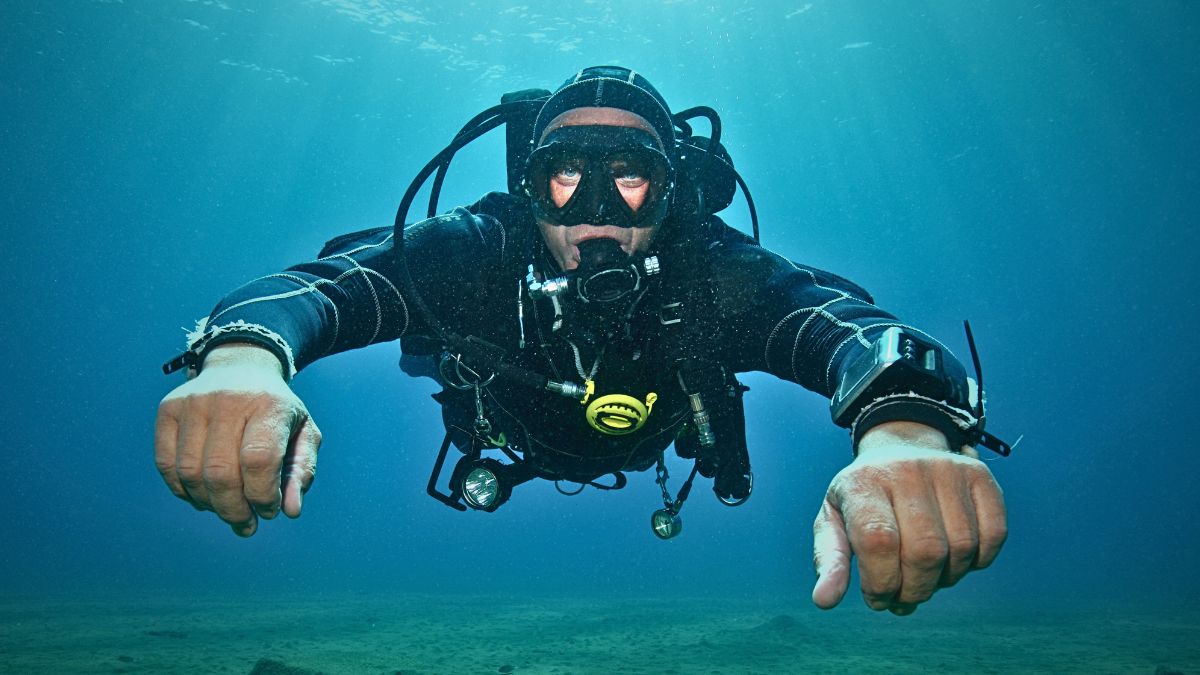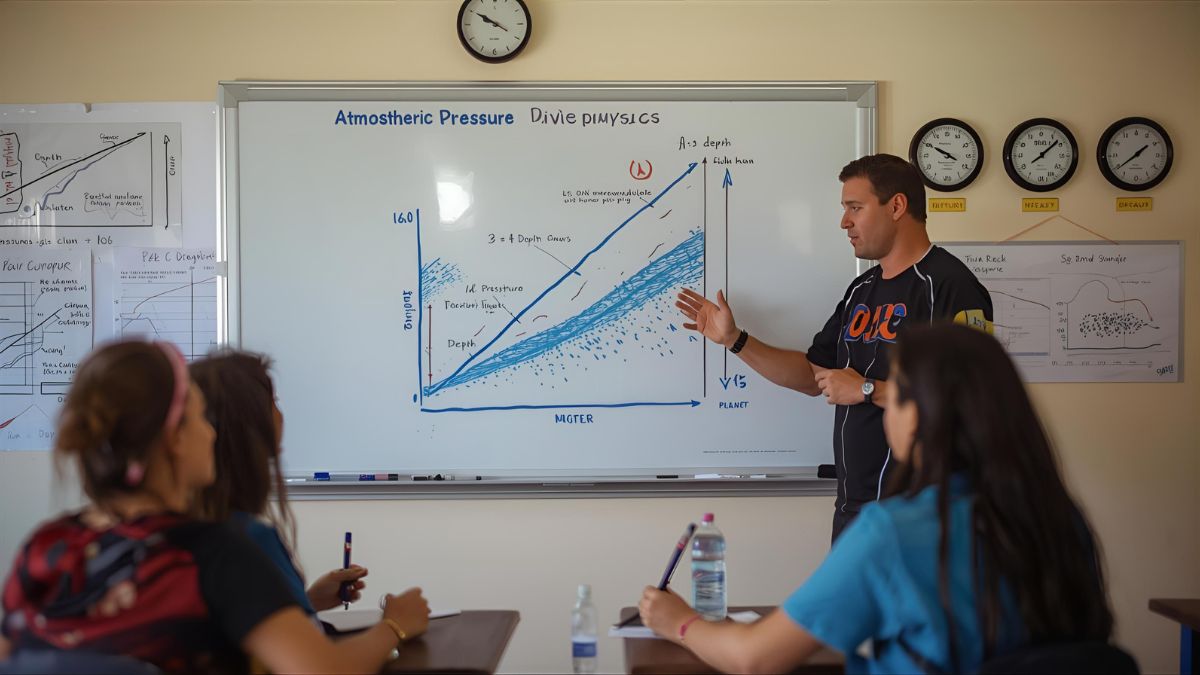Want to spot a beginner diver instantly? Just listen for someone talking about their “oxygen tank” or asking to borrow “goggles.” These simple mistakes don’t just reveal inexperience.
In some cases, they can actually point to gaps in safety knowledge that could put you or your buddy at risk. Proper diving terminology isn’t just about sounding knowledgeable or fitting in with experienced divers.
It’s about clear communication, safety, and demonstrating that you’ve been properly trained. When you use the wrong terms, other divers immediately question whether you understand the fundamentals. Mastering these terms is as important as mastering your buoyancy control.
I’ve been diving for years, and I still remember my first boat dive when someone asked if I had my “sausage.” I looked around confused, wondering if we were supposed to pack lunch. Everyone laughed, but that moment taught me something important: diving has its own language, and learning it is part of becoming a confident, competent diver.
In this guide, I’ll walk you through the most critical diving terminology mistakes and why they matter. Then we’ll cover the essential dive terminology every diver should know.
The Biggest Diving Terminology Mistakes (And Why They Matter)
Let’s start with the errors that make experienced divers cringe. These aren’t just irritating habits. Each one reveals a fundamental misunderstanding that could affect your safety underwater.
Never Say “Oxygen Tank” (Here’s Why It’s Dangerous)
This is the single biggest mistake in diving terminology, and it’s the one that raises the most red flags. When you say “oxygen tank,” you’re demonstrating that you don’t understand what you’re breathing underwater.
Here’s what’s actually in your scuba tank: compressed air. That means approximately 21% oxygen, 78% nitrogen, and about 1% trace gases. It’s the same air you’re breathing right now, just compressed to fit in a portable cylinder. We don’t breathe pure oxygen when diving. In fact, pure oxygen is toxic and deadly at depth.

Let me explain why this matters so much. Pure oxygen becomes toxic at depths below 6 meters (about 20 feet). This is called oxygen toxicity, and it can cause seizures, unconsciousness, and drowning. The maximum operating depth for pure oxygen is only 6 meters, which is why recreational divers use regular air instead.
Now, technical divers might use pure oxygen during decompression stops in very shallow water (above 6 meters). Some rebreather divers use oxygen as part of their gas mixture. But these are advanced techniques that require specialized training.
So what should you say instead? It’s simple:
- “Tank” or “cylinder” or “scuba tank”
- “Air” (for standard compressed air)
- “Nitrox” or “EAN” (if you’re using enriched air)
- “Gas” or “breathing gas” (generic term)
The right question isn’t “How much oxygen do you have?” It’s “How much air do you have?”
Did you know? Technical divers use specialized gas mixtures like trimix (helium, nitrogen, and oxygen) for deep dives. These mixtures help prevent nitrogen narcosis and reduce decompression obligations, but they require extensive training to use safely.
Goggles vs. Mask (Equipment That Could Save Your Life)
Another common mistake: calling your diving mask “goggles.” This isn’t just about using the wrong word. It’s about understanding the fundamental difference between recreational swimming equipment and life-support diving gear.
Swimming goggles cover only your eyes. They’re made of plastic and designed for pools. A diving mask covers your eyes and nose. It’s constructed with tempered glass designed to withstand significant water pressure.

Here’s why that nose coverage matters. As you descend, the air space inside your mask gets compressed by water pressure. To equalize this pressure, you need to blow a small amount of air from your nose into the mask. With goggles, this is impossible, and the pressure difference can cause serious damage.
Diving with swimming goggles can result in painful mask squeeze, burst blood vessels in your eyes, and even permanent damage.
Quality diving masks use tempered glass that can handle pressure at depth. They have a proper seal, nose pockets for equalization, and are tested to strict safety standards.
The correct term is always “mask,” “diving mask,” or “scuba mask.” Never “goggles.”
It’s a Snorkel, Not a Tube
Let’s tackle another simple but revealing mistake: calling your snorkel a “tube” or “pipe.” While this won’t get you into safety trouble like the oxygen tank error, it does show you’re not familiar with basic diving equipment.
A snorkel is that J-shaped breathing tube that attaches to your mask. It lets you breathe comfortably while floating face-down on the surface without wasting tank air. Modern snorkels have purge valves for easy water clearing and dry-top designs that close when submerged.
Snorkels serve an important safety function. If you’re swimming on the surface in choppy water, having a snorkel means you can keep your face down and breathe easily. It conserves your tank air when transiting to dive sites.
The proper term is “snorkel,” plain and simple.
The Depth Question That Reveals Inexperience
Here’s a question that comes up constantly: “How deep did you dive?” or “What’s the deepest you’ve been?”
While this might seem reasonable, asking about depth without context reveals a misunderstanding of what diving is about. It shows you think diving is about setting records or pushing limits.
Experienced divers don’t brag about maximum depth. They talk about their dive profile. A dive profile includes depth, time, activities, conditions, and what they saw. When we share stories, we describe the incredible marine life, the wreck we explored, or the underwater topography. Depth is just one small data point.
The proper way to ask? Try: “What kind of dives have you done?” or “What’s your most memorable dive?”
Fun fact: The recreational diving depth limit is typically 40 meters (130 feet) for advanced divers and 18 meters (60 feet) for newly certified divers. These limits are based on nitrogen absorption, oxygen toxicity risks, and nitrogen narcosis dangers.
Essential Diving Terminology Every Diver Should Know
Now that you know what NOT to say, let’s cover the essential diving terminology you should use. Understanding these core terms will help you communicate effectively with dive shops, instructors, and your dive team.
Equipment Terminology
BCD (Buoyancy Control Device)
This is the vest-like equipment you wear that holds your tank and regulator. The BCD is inflatable, allowing you to control buoyancy by adding or releasing air. You’ll hear it called BCD, BC, buoyancy compensator, or jacket. It’s the central hub of your diving setup.
Regulator / Regs
Your scuba diving regulator reduces high pressure from your tank to breathable pressure. It has two parts: the first stage (attaches to tank) and second stage (part you breathe from). Most divers shorten “regulator” to “regs.”
The “octopus” or “octo” is your alternate air source, a backup regulator for emergencies.

Fins (NOT Flippers)
This is another beginner giveaway. Those things on your feet are fins, never flippers. Flippers is pool terminology. Divers use fins.
Fins come as full-foot (entire foot inside) or open-heel (requires booties). Each type has advantages depending on conditions.
Wetsuit vs. Drysuit
Your exposure protection is either a wetsuit or drysuit. A wetsuit allows a thin water layer between your skin and suit. Your body heats this water for insulation. A drysuit keeps you completely dry with seals at neck and wrists.
Know which you’re wearing because they work differently and require different buoyancy management.
Certification and Safety Terms
C-Card / Certification Card
Your C-card is proof of completed training. It’s like your underwater driver’s license. You’ll need to show it whenever you dive with a shop or on a boat.
Don’t call it a “license” because that implies government regulation. It’s a certification from organizations like PADI, SSI, or NAUI.
Dive Buddy
In recreational diving, never dive alone. Your dive buddy is your partner underwater. You plan together, monitor each other, and are prepared to help in emergencies.
The buddy system isn’t a suggestion. It’s a fundamental safety protocol.
Safety Stop
At the end of most dives, you’ll make a safety stop: three minutes at 5 meters (15 feet). This gives your body time to off-gas excess nitrogen before surfacing, reducing decompression sickness risk.
Even though it’s called a “safety” stop, it’s considered best practice. Always include it in your ascent plan.
Did you know? The buddy system was formalized in the 1950s and has saved countless lives. Studies show that most diving fatalities involve solo divers or separated buddy teams.
Diving Procedure Terms
Dive Profile
This is what experienced divers discuss instead of just depth. Your dive profile includes depth over time, plus water temperature, visibility, and what you encountered.
When someone asks about your dive, describe the profile: “We did a 45-minute dive with a maximum depth of 18 meters, saw sea turtles, and made our safety stop at 5 meters.”
Buoyancy (Positive, Negative, Neutral)
You’re positively buoyant if you float, negatively buoyant if you sink, and neutrally buoyant when you hover. Achieving neutral buoyancy is one of the most important diving skills.
Master buoyancy control, and you’ll look graceful underwater, consume less air, and protect marine environments.
Visibility / Vis
When divers discuss conditions, visibility is key. “Vis” is how far you can see underwater. Good vis might be 20-30 meters, while poor vis might be 3-5 meters.
Visibility affects dive planning, buddy procedures, and navigation.
Understanding Breathing Gas Terminology
Now let’s explore breathing gas terminology in more detail.
Air vs. Oxygen
We’ve covered this, but it bears repeating. Air is the mixture we normally breathe: 21% oxygen and 78% nitrogen. Oxygen refers to pure O2, used only in specific, controlled situations.
Always say “air” unless you’re talking about something else.
Nitrox / EAN / Enriched Air
Nitrox is a breathing gas with higher oxygen than normal air. Common mixtures are EAN32 (32% oxygen) and EAN36 (36% oxygen). Divers use nitrox to reduce nitrogen absorption, allowing longer bottom times.
However, higher oxygen means more careful depth management to avoid toxicity. Using nitrox requires special certification.

Technical Gases
Technical divers use trimix (helium, nitrogen, oxygen) or heliox (helium, oxygen) for deep dives. These help prevent nitrogen narcosis and reduce decompression on extreme dives.
You don’t need details unless pursuing technical diving, but knowing these exist shows you understand the broader diving world.
Quick Reference: Diving Terminology Do’s and Don’ts
To help you remember these key distinctions, here’s a quick reference guide you can bookmark:

Frequently Asked Questions
Why is saying “oxygen tank” such a serious mistake?
Pure oxygen is toxic below 6 meters and can cause seizures and death. Divers breathe compressed air or other mixtures, not pure oxygen. Using wrong terminology indicates you might not understand this fundamental safety concept.
Do all divers use the same terminology worldwide?
Core diving terminology is standardized internationally through organizations like PADI, SSI, and NAUI. Terms like BCD, regulator, and safety stop are universal, though minor regional variations exist.
How important is using correct terminology for safety?
Very important. Clear communication underwater and on the surface is essential. Proper terminology during briefings, equipment checks, and emergencies ensures everyone knows exactly what you mean.
What’s the difference between slang and proper terminology?
Slang terms like “sausage” (SMB) or “narc’d” (nitrogen narcosis) are casual language among divers. Proper terminology is standardized for training, safety, and equipment discussions. Learn both, but prioritize proper terms for safety-critical communications.
Will experienced divers judge me for wrong terms?
Honestly? Yes. Experienced divers can gauge your training level from vocabulary. More importantly, incorrect terminology raises safety concerns. If you say “oxygen tank,” dive professionals worry you haven’t grasped basic gas physiology.
Where can I learn more diving terminology?
Your certification course covers essential diving terminology as part of the curriculum. Beyond that, time at dive shops, diving communities, reading publications, and advanced courses all expand your vocabulary naturally.
What’s the first dive terminology I should learn as an absolute beginner?
Start with these five critical terms: tank or air (never “oxygen tank”), mask (not goggles), fins (not flippers), dive buddy (your safety partner), and safety stop (three minutes at 5 meters). Master these basics, and you’ll have the foundation for all other diving vocabulary. Your certification course will build on these fundamentals.
Master Diving Terminology for Safer, More Confident Diving
Learning proper diving terminology isn’t about impressing people. It’s about safety, clear communication, and demonstrating you understand the fundamentals.
The mistakes we covered are red flags indicating gaps in understanding that could affect safety underwater.
Start with the critical terms: tank (not oxygen tank), mask (not goggles), air (not oxygen), and dive profile (not just depth). Master these, and you’ll immediately sound more knowledgeable.
As you gain experience, the rest will become second nature. You’ll naturally talk about your BCD, discuss vis with your team, and plan based on complete profiles.
Before your next dive, review the diving terminology in this guide. Practice using proper terms when talking about diving. The more you use correct diving terminology, the more confident you’ll become.
Remember: clear communication saves lives underwater. Speaking the language of diving isn’t just about fitting in. It’s about being a safe, competent member of the diving community.
Sources
For more information about diving safety and proper terminology, consider these authoritative resources:
- PADI (Professional Association of Diving Instructors) – Standards and terminology guidelines
- DAN (Divers Alert Network) – Diving safety research and medical information
- SSI (Scuba Schools International) – Training standards and diving education
These organizations set international standards for diving terminology and safety protocols.





